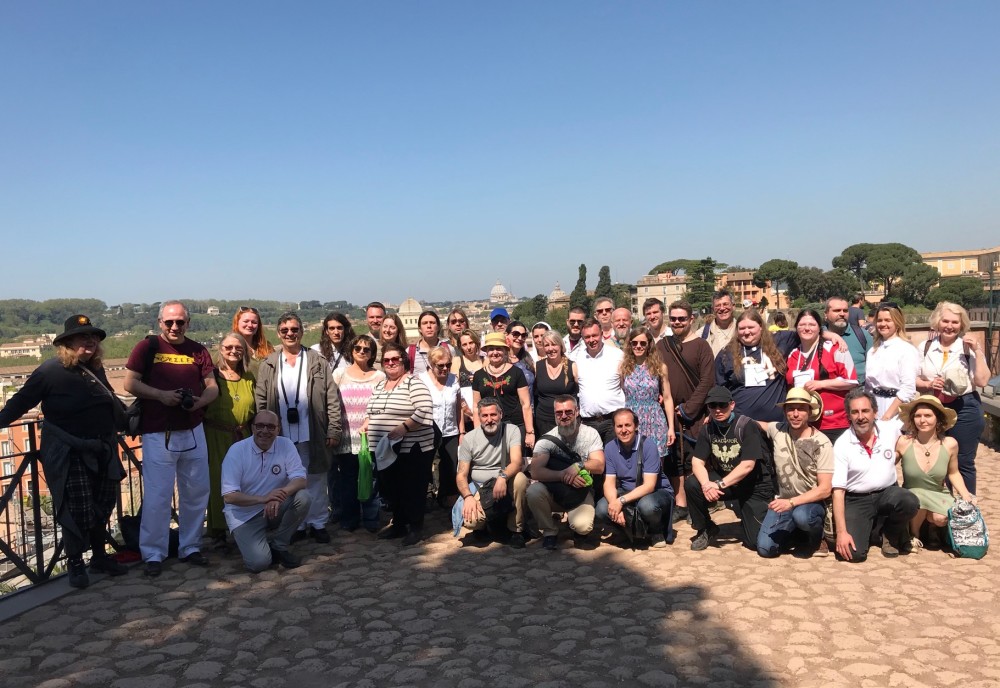 A great four-day event, with the participation of delegations from fifteen European countries and a representation from the US, culminated in an intense and luminous common ritual on the sacred hill of the Palatine on the 2771st anniversary of Rome foundation, the “Dies Natali”. So it was the sixteenth Congress of the ECER – European Congress of Ethnic Religions, organized by the Movimento Tradizionale Romano on the theme “The pagan rituals and their sources” (19 – 22 April 2018), concluded in Rome with great success, thanks to the synergy of prestigious doctrinal and scientific contributions and an impeccable organization.
A great four-day event, with the participation of delegations from fifteen European countries and a representation from the US, culminated in an intense and luminous common ritual on the sacred hill of the Palatine on the 2771st anniversary of Rome foundation, the “Dies Natali”. So it was the sixteenth Congress of the ECER – European Congress of Ethnic Religions, organized by the Movimento Tradizionale Romano on the theme “The pagan rituals and their sources” (19 – 22 April 2018), concluded in Rome with great success, thanks to the synergy of prestigious doctrinal and scientific contributions and an impeccable organization.
in fact, the ECER, that brings together the main representative associations of European ethnic religions, had asked MTR to hold the prestigious event in the Italian capital: the MTR accepted and decided to celebrate the Congress on the occasion of the Natal of Rome.
The first two days, 19 and 20 April, the Congress took place in the prestigious Palazzo Ferrajoli, rented by MTR for the event, in Piazza Colonna, in the heart of the Eternal City (the program of the event). The weather was splendid with the first spring warmth, a sign of the favors of the Sky.
After the aperture of the works by Puccini’s Hymn to Rome, the president of the MTR Daniele Liotta introduced the Congress by welcoming the numerous guests. The president underlined the great importance of such an event for Rome and for Italy, where it is very rare to have an international, spiritual, and doctrinal meeting on the so-called “pagan” religions practiced in Europe today.
Then, the vice president of MTR, the prince Guglielmo Giovanelli Marconi, drew a historical picture of the hosting palace, recalling the symbolic value of celebrating the Congress in front of the column of Marcus Aurelius, the Roman emperor philosopher, who gave a unique testimony in his Memories of his direct relationship with the Gods.
After the greetings of the president of the ECER Andras Corban-Arthen, the core part of the works started, led by Paolo Casolari, journalist and director of the MTR..
Each national group presented both its own practices and the specific doctrinal, historical and anthropological research on the sources of its own rite. In the first two days of the congress, the presentations of all the main representative associations of the European ethnic religions followed.
The following speakers presented their work: Agnija Saprovska, Ramants Janson and Daris Jansons, Foundation Maras Loks (Latvia); Goedele Janssens, Joris De Vriendt and Michel Hubert, Traditie (Belgium); Nina Bukala, Traditie (Holland), Sandra Keuper, Asatru (Germany); Zdenek Ordelt, Nami Lada and Marianna Gorronova, Slavonic Circle (Czech Republic); Øyvind Siljeholm, Ravn Villtokt and Skade Villtokt, Forn Sed (Norway); Christoffer Skauge Eid, Sjamanistisk Forbund (Norway); Jean Lionel Manquat and Jean Marc Duvette, Druidic Group of Gaul (France); Vlassis Rassias and Konstantine Malliaros, Supreme Council of Ethnikoi Hellenes – YSEE (Greece); Halyna Lozko (Zoreslava), Jaroslav Balanovskyi and Yurii Tsvirkun (Jarosvit), The Association of the Believers of the Ukrainian Native Faith (Ukraine); Inija Trinkuniene, Irena Balkune, Romuva ( Lithuania); Prudence Capelle, Romuva (United States of America), Miroslav Kiselev and Svetozara Pronina, The Union of Slavic Communities of the Slavic Native Belief (Russia); Andras Corban-Arthen, The Earth Spirit Community (Spain and United States of America); Federico Fregni and Eleonora Stella, Societas Hesperiana (Italy); and of course the Movimento Tradizionale Romano.
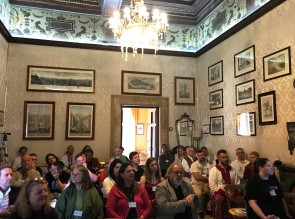 In addition, there were: Mikael Victor Mikulenas (Denmark), Thomas Dana Lloyd (Italy, Roman Politics) and Edoardo Paulin (Italy), and all the other representatives of the foreign delegations who accompanied their speakers.
In addition, there were: Mikael Victor Mikulenas (Denmark), Thomas Dana Lloyd (Italy, Roman Politics) and Edoardo Paulin (Italy), and all the other representatives of the foreign delegations who accompanied their speakers.
In particular, the presentation of MTR, made by President Liotta, introduced all the characteristics and sources (literary, historical and archaeological) of the Roman Private Rite practiced today, full of attention to perfection and expression of religiosity (Pietas) that requires respect absolute of the ritual, exact recitation of the prayer, impeccable execution of the gestures.
Then, the insights on tradition, Roman, and Italic, carried out by experts, were very interesting.
The archaeologist PhD Sandra Mazza, recently enrolled in the MTR, presented a study on the Roman rite of foundation, developing all the phases of the foundation of the city in the work of historians and Latin and Greek scholars. The philosopher of Tradition, the lawyer Giandomenico Casalino, then presented “Rome and the magical power of the rite” and theorized how the Roman essence belongs to the Royal initiatic Tradition and is, therefore, of a warlike nature and heroic variation of the Primordial Unique Tradition. For these reasons, according to Casalino, the Roman religion has no spiritual need for mythic, symbolic, mystery or theurgic mediation, unlike almost all other religious traditions. Finally, Dr. Valdis Steins (former member of the Latvian parliament and historian of conservatism in Europe), with Margarita Steina, has drawn a picture of “The rites, temples and prehistory“, carrying out an unusual anthropological study on migration, relations and on the affinities existing between the ancient Latvians and the populations of pre-Roman Italy, especially Etruscans.
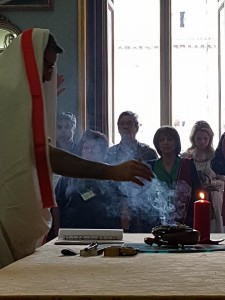 The first day ended with a convivial dinner, while the second day, at the end of the works at Palazzo Ferrajoli, ended with a guided visit to the Pantheon, the only Roman temple still intact in its substantially original layout.
The first day ended with a convivial dinner, while the second day, at the end of the works at Palazzo Ferrajoli, ended with a guided visit to the Pantheon, the only Roman temple still intact in its substantially original layout.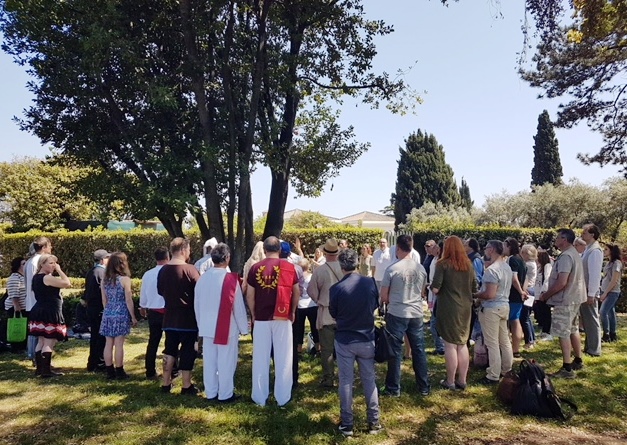
The third conference day, Saturday 21 April, was the core of the Roman event of ECER.
In the early morning, in fact, most of the participants met in Via di S. Gregorio for a visit to the Palatine Hill and the Imperial Forums. It was not, however, a mere archaeological walk, but a true spiritual itinerary on the Sacred Hill of our Tradition.
Accompanied by the archaeologists Marina Simeone and Sandra Mazza, the participants were able to immerse themselves completely in the environment and at the same time feed themselves from the most sacred sources of our Roman Tradition. The in-depth illustrations and the direct vision of the still impressive architectural evidences, such as the huts of Romulus, the temple of Apollo, the house of Augustus, the palaces of Domitian, were the setting for the presentation. In particular, the amazement has caught everyone in learning that the Christian birth was born under their feet, in the fourth century, in the church of St. Anastasia, on the expropriated trunk of the feast of the Invincible Sun (Sol Invictus) and on the forgotten roots of the Lupercal – our only , true, Cave of the Nativity.
In the middle of the day, the common ritual took place under the branches of a magnificent laurel. Opened by President MTR Daniele Liotta, the intense and lasting ceremony saw the active participation, with offers, hymns, songs, prayers, and music, of all the representative groups of the European ethnic religions. It was a long solemn and magical moment that proved how a single chain in the spirit can get through to Heaven, each group and participant through his own Door, receiving the power of the sacred day of Natal of Rome.
The visit then proceded to the Fora, with flower offerings at the temple of Vesta and at the temple of the Divine Caesar by the delegates. In the afternoon the day ended with a visit to the Colosseum.
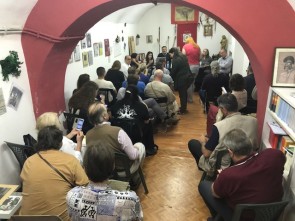 The fourth day of the Congress, on Sunday 22 April, took place at the MTR’s headquarters. The event started with the proposal of President MTR Liotta to identify a common prayer to the Sun / Apollo, intended to be recited by all at the same time, on the occasion of the Summer Solstice, which is a celebration shared by all the participating religious associations. Following, ECER President Andras Corban drew up a review of the activities and the growth prospects of ECER, which is gaining more adhesions. Furthermore porposed guidelines for future initiatives, gathering the indications of the delegates: the meeting saw an in-depth exchange of views. Corban also suggested the next congress in Galizia, in two years.
The fourth day of the Congress, on Sunday 22 April, took place at the MTR’s headquarters. The event started with the proposal of President MTR Liotta to identify a common prayer to the Sun / Apollo, intended to be recited by all at the same time, on the occasion of the Summer Solstice, which is a celebration shared by all the participating religious associations. Following, ECER President Andras Corban drew up a review of the activities and the growth prospects of ECER, which is gaining more adhesions. Furthermore porposed guidelines for future initiatives, gathering the indications of the delegates: the meeting saw an in-depth exchange of views. Corban also suggested the next congress in Galizia, in two years.
In the end, the unanimous acknowledgments were expressed, by the ECER Presidency and by the foreign groups, to the MTR for the organization of the Congress.
A special recognition for the enthusiastic and voluntary commitment, lavished without stopping in four long days of Congress, goes to Italo Linzalone, Pietro Rosetti, Ermes Paparoni, Marco Felli, Fulvio Noja, Gregorio Lo Coco, Stefano Guidi and Georgios Michaloudis of MTR, and we add also our frater Mario Basile, who has always collaborated on the success of the event from the Netherlands, and the tireless coordinator of the organizing secretary, Giulia.
P.C.


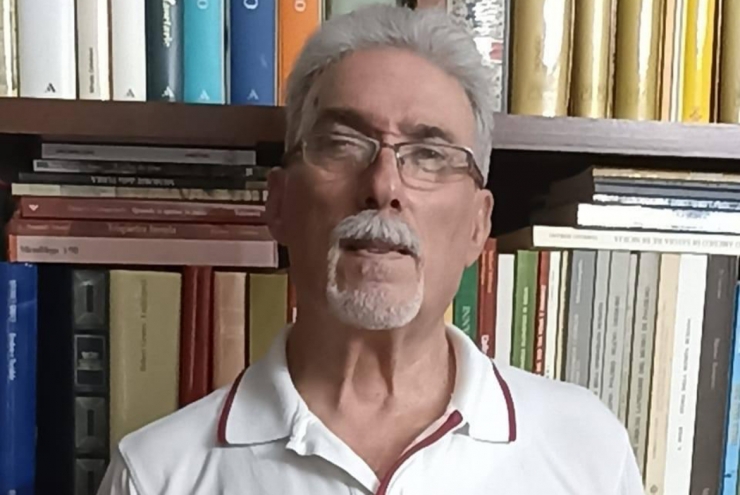



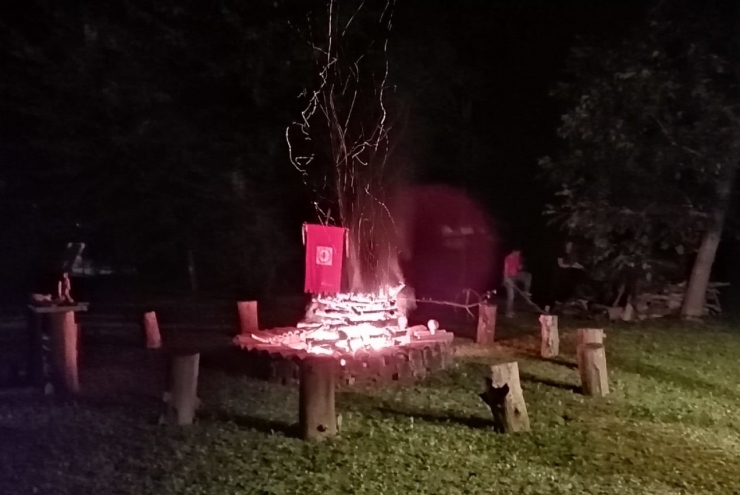


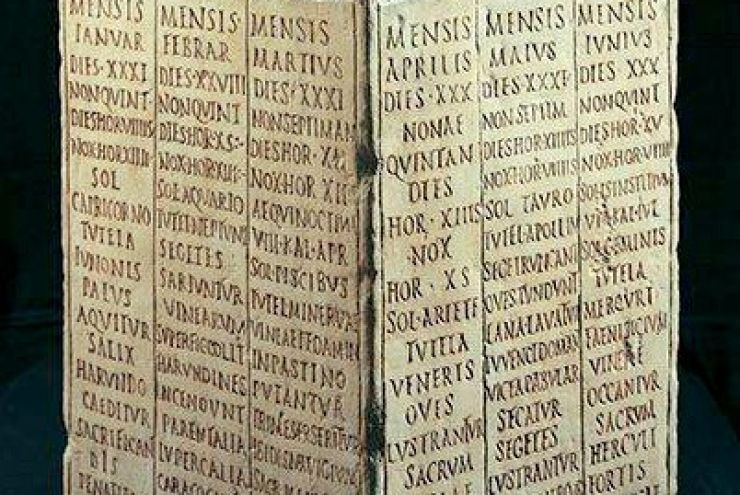







Un pensiero riguardo “For the first time in Rome the European Congress of Ethnic Religions”
I commenti sono chiusi